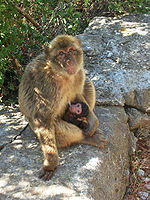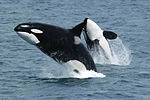List of mammals of Gibraltar
Appearance
This is a list of the mammal species recorded in Gibraltar. There are twenty-four mammal species in Gibraltar, of which one is critically endangered, one is endangered, three are vulnerable, and one is near threatened.[1]
The following tags are used to highlight each species' conservation status as assessed by the International Union for Conservation of Nature:
| EX | Extinct | No reasonable doubt that the last individual has died. |
| EW | Extinct in the wild | Known only to survive in captivity or as a naturalized populations well outside its previous range. |
| CR | Critically endangered | The species is in imminent risk of extinction in the wild. |
| EN | Endangered | The species is facing an extremely high risk of extinction in the wild. |
| VU | Vulnerable | The species is facing a high risk of extinction in the wild. |
| NT | Near threatened | The species does not meet any of the criteria that would categorise it as risking extinction but it is likely to do so in the future. |
| LC | Least concern | There are no current identifiable risks to the species. |
| DD | Data deficient | There is inadequate information to make an assessment of the risks to this species. |
Order: Chiroptera (bats)
[edit]
- Suborder: Microchiroptera
- Family: Vespertilionidae
- Genus: Myotis
- Greater mouse-eared bat, Myotis myotis LC extirpated
- Genus: Pipistrellus
- Soprano pipistrelle, Pipistrellus pygmaeus DD
- Genus: Miniopterus
- Schreibers' long-fingered bat, Miniopterus schreibersii DD
- Genus: Myotis
- Family: Molossidae
- Genus: Tadarida
- European free-tailed bat, Tadarida teniotis DD
- Genus: Tadarida
- Family: Rhinolophidae
- Subfamily: Rhinolophinae
- Genus: Rhinolophus
- Greater horseshoe bat, R. ferrumequinum LC extirpated[2]
- Lesser horseshoe bat, R. hipposideros LC extirpated
- Genus: Rhinolophus
- Subfamily: Rhinolophinae
- Family: Vespertilionidae

- Family: Cercopithecidae
- Genus: Macaca
- Barbary macaque, M. sylvanus EN introduced[3]
- Genus: Macaca








- Suborder: Mysticeti
- Family: Balaenopteridae (rorquals)
- Genus: Balaenoptera
- Fin whale, Balaenoptera physalus VU
- Common minke whale, Balaenoptera acutorostrata LC
- Genus: Balaenoptera
- Family: Balaenopteridae (rorquals)
- Suborder: Odontoceti
- Family: Physeteridae (sperm whales)
- Genus: Physeter
- Sperm whale, Physeter macrocephalus EN
- Genus: Physeter
- Family: Ziphiidae (beaked whales)
- Genus: Ziphius
- Cuvier's beaked whale, Ziphius cavirostris VU
- Family: Delphinidae (marine dolphins)
- Genus: Tursiops
- Common bottlenose dolphin, Tursiops truncatus VU
- Genus: Steno
- Rough-toothed dolphin, Steno bredanensis DD
- Genus: Tursiops
- Genus: Stenella
- Striped dolphin, Stenella coeruleoalba VU
- Genus: Delphinus
- Short-beaked common dolphin, Delphinus delphis EN
- Genus: Grampus
- Risso's dolphin, Grampus griseus DD
- Genus: Globicephala
- Long-finned pilot whale, Globicephala melas DD
- Genus: Orcinus
- Orca, Orcinus orca DD
- Genus: Ziphius
- Family: Physeteridae (sperm whales)
- Family: Muridae (rats and mice)
- Genus: Rattus
- Genus: Mus
- House mouse, Mus musculus LC
Order: Lagomorpha (rabbits and hares)
[edit]
- Family: Leporidae
- Genus: Oryctolagus
- European rabbit, Oryctolagus cuniculus EN
- Genus: Oryctolagus
Order: Artiodactyla (even-toed ungulates)
[edit]The even-toed ungulates are ungulates whose weight is borne about equally by the third and fourth toes, rather than mostly or entirely by the third as in perissodactyls. There are about 220 artiodactyl species, including many that are of great economic importance to humans.
- Family: Bovidae (bovids)
- Subfamily: Caprinae
- Iberian ibex, C. pyrenaica LC extirpated
- Southeastern Spanish ibex, C. p. pyrenaica extirpated
- Iberian ibex, C. pyrenaica LC extirpated
- Subfamily: Caprinae
See also
[edit]Wikimedia Commons has media related to Mammals of Gibraltar.
- Barbary macaques in Gibraltar
- List of birds of Gibraltar
- List of chordate orders
- Lists of mammals by region
- Mammal classification
- List of mammals described in the 2000s
References
[edit]- ^ "Mammals". Gibraltar Ornithological and Natural History Society. Archived from the original on 11 January 2018. Retrieved 11 January 2018.
- ^ Piraccini, R. (2016). "Rhinolophus ferrumequinum". IUCN Red List of Threatened Species. 2016: e.T19517A21973253.
- ^ C. Michael Hogan. 2008. Barbary Macaque: Macaca sylvanus, Globaltwitcher.com, ed. N. Strõmberg Archived 2012-04-19 at the Wayback Machine

